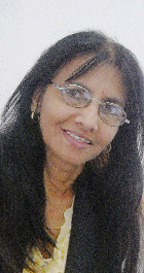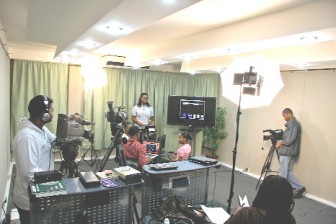Head of the recently established Educational Television Broadcasting Service (ETBS) Dr Seeta Shah Roath has said that new channel was conceived as a resource to aid teachers in carrying out their lesson plans.
“The intention is to provide instructional material and teaching the teachers how to integrate the material into their lesson planning, not for the technology to take over the lesson or replace the teacher,” Shah Roath told Stabroek News. “We are trying to be creative and innovative,” she added.
On April 1, President Bharrat Jagdeo launched the ETBS at the National Centre for Educational Resource Development (NCERD), saying that it will narrow the gaps in providing quality education across the country.

ETBS, which operates from NCERD, is aired on channel 29 and cable 80. According to Shah Roath, the channel is currently being funded by the Ministry of Education and it was established using the Public Broadcasting Service model that India, Mexico, the UK and the United States employ. No commercials will be aired on the channel; rather, Public Service Announcements will be aired between sessions. “We are open to all possibilities except commercials,” Shah Roath noted.
A hit with parents
The channel broadcasts entertaining but educational content for all ages from pre-nursery to general education shows. “Right now we are reaching residents close to Anna Regina and West Berbice and right up to Long Creek,” she said, while adding that “We had feedback from all over; people are just calling in and saying that the quality is excellent [and] they appreciate the content.” Parents are particularly pleas-ed with the content broadcast, she said, with many declaring that they had finally found a channel that caters for children.
The satellite broadcast system cost the government a little less than US$1M. The day’s schedule is broadcast between 6am and 9am. The nursery programmes start at 9am. “We have done a preliminary survey and noted that most day care centres [and] nursery schools have TVs…” and show programmes that are similar in content as the ETBS, therefore “it complements our curriculum,” Shah Roath noted. She also said that in order to ensure that every institution benefits, management is willing to assist those that do not have television sets, with acquiring one.
As the day progresses, shows for other educational levels are aired. “What is shown for the high school students is rebroadcast in the afternoons after four and again into the night,” she noted. In addition to programmes designed to complement the curriculum of the various educational levels, cultural shows and general education shows dealing with physical fitness and home economics are aired. In the evenings, a movie that is educational in nature or has a positive message is aired at 8pm. The channel signs off at 11pm.
‘For young people,
by young people’
Regarding the content of programmes, Shah Roath said, “We are actually producing. Because we are producing and acquiring content, we are using the content expert combined with the curriculum guide and instructional design methodology and we [are] combining all of that to produce programmes that are pedagogical and intended to meet specific outcomes.” She noted too that the basic design in terms of the television aspect of the channel is to capture its audience and retain their interest.

For content created locally, Shah Roath noted that most of it is pre-tested. “The intention is to pre-test all of it,” she said. Content is created “for young people by young people.” While many members of the staff are University of Guyana graduates, with production and other required qualifications, they also undergo training in the production of educational materials. As for the content that is imported, Shah Roath said it comes from The Indira Ghandi Open University, in India. Some of it is also coming from countries that have similar content like the UK, Canada, Barbados, Trinidad and Jamaica. “The idea is to acquire content that is appropriate to our curriculum,” she explained.
Shah Roath has been in television production for a number of years. She completed her Diploma in Com-munication at the University of Guyana and later became the Media Producer at the University’s Centre for Communication Studies. She then completed her Masters in Education, Distance Learning and Adult Education and her doctorate in Education-Edu-cation Leadership Curriculum and Instruction. She is said to have developed the first children’s television series for the then Guyana Television (GTV). As the head of the National Development Sup-port Communication System, Shah Roath produced several television documentaries both for broadcast and corporate use. She also served as the Public Communications Coordinator of Omai Gold Mines Limited.





